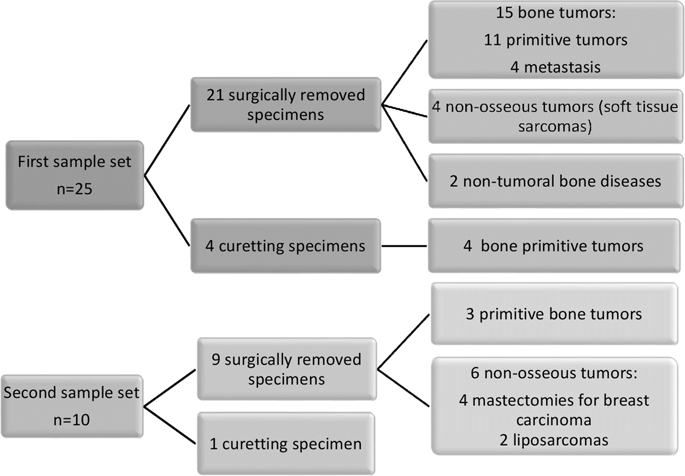Modern Pathology ( IF 7.1 ) Pub Date : 2020-02-24 , DOI: 10.1038/s41379-020-0503-6 Elodie Miquelestorena-Standley 1, 2 , Marie-Lise Jourdan 3 , Christine Collin 3 , Corinne Bouvier 4 , Frédérique Larousserie 5 , Sébastien Aubert 6 , Anne Gomez-Brouchet 7 , Jean-Marc Guinebretière 8 , Matthias Tallegas 1, 2 , Bénédicte Brulin 9 , Louis-Romée Le Nail 2, 9, 10 , Anne Tallet 3 , François Le Loarer 11 , Jessica Massiere 11 , Christine Galant 12 , Gonzague de Pinieux 1, 2, 9

|
Diagnosis of osteocartilaginous pathologies depends on morphological examination and immunohistochemical and molecular biology analyses. Decalcification is required before tissue processing, but available protocols often lead to altered proteins and nucleic acids, and thus compromise the diagnosis. The objective of this study was to compare the effect of different methods of decalcification on histomolecular analyses required for diagnosis and to recommend an optimal protocol for processing these samples in routine practice. We prospectively submitted 35 tissue samples to different decalcification procedures with hydrochloric acid, formic acid, and EDTA, in short, overnight and long cycles for 1 to >10 cycles. Preservation of protein integrity was examined by immunohistochemistry, and quality of nucleic acids was estimated after extraction (DNA and RNA concentrations, 260/280 ratios, PCR cycle thresholds), analysis of DNA mutations (high-resolution melting) or amplifications (PCR, in situ hybridization), and detection of fusion transcripts (RT-PCR, in situ hybridization). Hydrochloric acid- and long-term formic acid-based decalcification induced false-negative results on immunohistochemistry and molecular analysis. EDTA and short-term formic acid-based decalcification (<5 cycles of 6 h each) did not alter antigenicity and allowed for detection of gene mutations, amplifications or even fusion transcripts. EDTA showed superiority for in situ hybridization techniques. According to these results and our institutional experience, we propose recommendations for decalcification of bone samples, from biopsies to surgical specimens.
中文翻译:

脱钙方案对骨样本免疫组织化学和分子分析的影响。
骨软骨病变的诊断取决于形态学检查以及免疫组织化学和分子生物学分析。组织处理前需要脱钙,但可用的方案通常会导致蛋白质和核酸发生改变,从而影响诊断。本研究的目的是比较不同脱钙方法对诊断所需的组织分子分析的影响,并推荐在常规实践中处理这些样本的最佳方案。我们前瞻性地将 35 个组织样本提交给不同的脱钙程序,使用盐酸、甲酸和 EDTA,短周期、过夜和长周期 1 到 >10 个周期。通过免疫组织化学检查蛋白质完整性的保存,在提取(DNA 和 RNA 浓度、260/280 比率、PCR 循环阈值)、DNA 突变分析(高分辨率熔解)或扩增(PCR、原位杂交)以及融合转录物检测后评估核酸和质量(RT-PCR,原位杂交)。盐酸和长期基于甲酸的脱钙引起免疫组织化学和分子分析的假阴性结果。EDTA 和基于甲酸的短期脱钙(<5 个循环,每个循环 6 小时)不会改变抗原性,并允许检测基因突变、扩增甚至融合转录本。EDTA 显示出原位杂交技术的优越性。根据这些结果和我们的机构经验,我们提出了骨样本脱钙的建议,











































 京公网安备 11010802027423号
京公网安备 11010802027423号